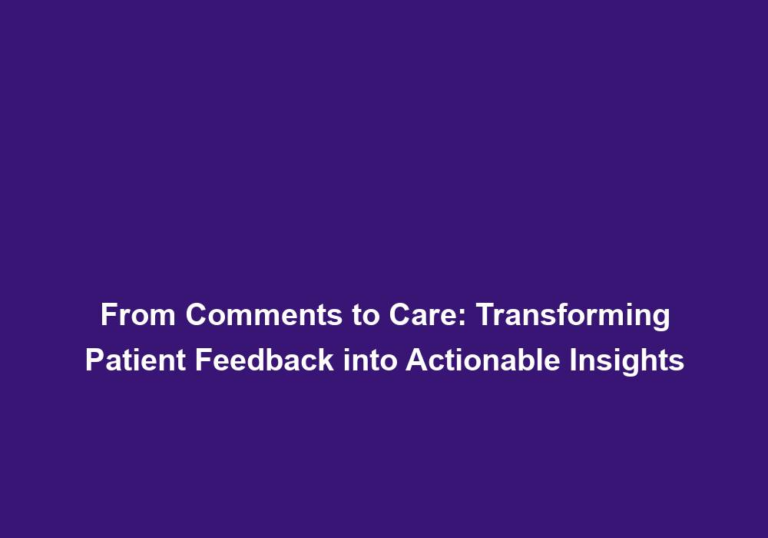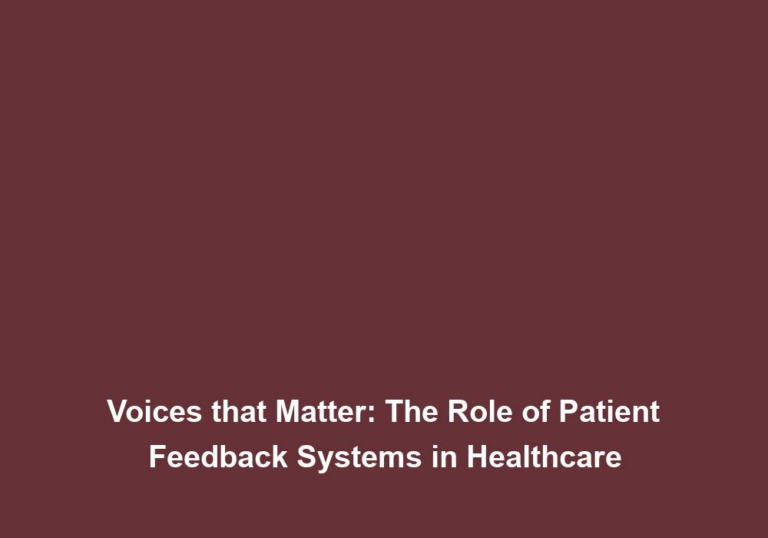Feedback Foundations: Building Systems that Amplify Patient Voices
In the ever-evolving landscape of healthcare, patient feedback has become an invaluable source of knowledge and insight for improving the quality of care. By actively seeking and effectively utilizing patient voices, healthcare providers can gain a deeper understanding of their patients’ experiences, needs, and preferences. This article will explore the importance of feedback in healthcare, discuss the key elements of a successful feedback system, and provide practical tips for building systems that amplify patient voices.
The Power of Patient Feedback
Patient feedback holds immense potential for driving positive change in healthcare. It allows healthcare providers to:
- Enhance patient-centered care: By actively listening to patients’ experiences and perspectives, healthcare providers can gain valuable insights into what truly matters to their patients. This enables them to deliver care that is tailored to individual needs and preferences, ultimately improving patient satisfaction and outcomes.
Patient-centered care is a fundamental aspect of healthcare that prioritizes the individual needs and preferences of patients. By actively seeking feedback from patients, healthcare providers can gain a deeper understanding of their experiences and perspectives. This feedback can provide valuable insights into the aspects of care that are most important to patients, allowing providers to deliver personalized and tailored care that meets their unique needs. By incorporating patient feedback into the decision-making process, healthcare providers can enhance patient-centered care and improve patient satisfaction and outcomes.
- Identify areas for improvement: Patient feedback serves as a valuable source of data that highlights areas where the healthcare system may be falling short. By listening to patient concerns, healthcare providers can identify and address issues, ultimately leading to improved quality of care and overall patient experience.
Patient feedback serves as a critical source of information for identifying areas where the healthcare system may need improvement. By actively listening to patient concerns and experiences, healthcare providers can gain insights into the areas where they may be falling short. This feedback can highlight issues such as long wait times, communication gaps, or difficulties accessing care. By addressing these concerns and making necessary improvements, healthcare providers can enhance the quality of care and the overall patient experience.
- Drive innovation: Patient feedback often contains ideas and suggestions for improving healthcare delivery. By actively encouraging and considering patient ideas, healthcare providers can foster a culture of innovation and continuous improvement.
Patient feedback is not only valuable for identifying areas of improvement but also for driving innovation in healthcare delivery. Patients often have unique perspectives and ideas that can contribute to the development of new approaches and solutions. By actively encouraging and considering patient ideas, healthcare providers can foster a culture of innovation and continuous improvement. This can lead to the development of new technologies, processes, or services that enhance the overall healthcare experience for patients.
- Build trust and transparency: Effective feedback systems demonstrate to patients that their opinions are valued and taken seriously. This promotes trust between patients and healthcare providers, enhancing the patient-provider relationship and overall patient satisfaction.
Building trust and transparency is crucial in healthcare, and effective feedback systems play a significant role in achieving this. When healthcare providers actively seek and listen to patient feedback, it demonstrates that their opinions are valued and taken seriously. This fosters a sense of trust between patients and providers, enhancing the patient-provider relationship. Patients feel more engaged and empowered when they know their voices are heard, leading to increased patient satisfaction and improved healthcare outcomes.
Key Elements of a Successful Feedback System
A successful feedback system should be designed to capture, analyze, and act upon patient feedback in a systematic and meaningful way. The following are key elements that should be considered when building a feedback system:
1. Clear and Accessible Channels
To effectively collect patient feedback, healthcare providers must establish clear and accessible channels for patients to share their experiences and concerns. This may include online portals, surveys, suggestion boxes, or dedicated feedback hotlines. It is crucial to ensure that these channels are user-friendly, available in multiple languages, and widely promoted to encourage maximum participation.
Clear and accessible channels are essential for capturing patient feedback. Healthcare providers should offer various options for patients to share their experiences and concerns, including online portals, surveys, suggestion boxes, or dedicated feedback hotlines. These channels should be easy to use, available in multiple languages to accommodate diverse patient populations, and widely promoted to ensure maximum participation. By providing clear and accessible channels, healthcare providers can encourage patients to provide feedback and ensure that their voices are heard.
2. Anonymity and Confidentiality
Patients may be hesitant to provide feedback if they fear their identity will be compromised. Anonymity and confidentiality should be prioritized to create a safe space for patients to share their thoughts openly and honestly. Patient feedback should be treated with the utmost confidentiality, and measures should be in place to protect patient privacy throughout the feedback collection and analysis process.
Anonymity and confidentiality are crucial factors in building trust and encouraging patients to provide honest feedback. Patients may be reluctant to share their thoughts if they fear their identity will be revealed. Healthcare providers should prioritize creating a safe and confidential environment for patients to share their experiences and concerns. This can be achieved by implementing measures such as anonymous feedback options, secure data storage, and strict protocols for handling and analyzing patient feedback. By ensuring anonymity and confidentiality, healthcare providers can create a safe space for patients to provide honest feedback without fear of repercussions.
3. Timely and Regular Feedback Loop
A successful feedback system requires a timely and regular feedback loop, allowing patients to see the impact of their feedback. Healthcare providers should establish mechanisms for acknowledging receipt of feedback, providing updates on actions taken, and closing the loop with patients. This fosters a sense of accountability and demonstrates that patient voices are valued and influential.
Timely and regular feedback loops are essential for maintaining patient engagement and demonstrating the value of their feedback. Healthcare providers should establish mechanisms to acknowledge and respond to patient feedback in a timely manner. This can include automated email notifications to confirm receipt of feedback, regular updates on actions taken to address concerns, and closing the loop by informing patients of the outcomes or improvements resulting from their feedback. By establishing a feedback loop, healthcare providers demonstrate accountability, show that patient voices are valued, and encourage ongoing participation in the feedback process.
4. Data Collection and Analysis
Collecting feedback is just the first step; thorough analysis is essential to extract meaningful insights. Healthcare providers should invest in data collection tools and analytics platforms that enable them to identify patterns, trends, and recurring themes in patient feedback. This data-driven approach ensures that decisions and actions are based on evidence and helps prioritize areas for improvement.
Data collection and analysis are critical for transforming patient feedback into meaningful insights. Healthcare providers should invest in data collection tools and analytics platforms that allow them to effectively analyze and interpret patient feedback. By using these tools, providers can identify patterns, trends, and recurring themes in the feedback data. This data-driven approach ensures that decisions and actions are based on evidence, making it easier to prioritize areas for improvement. By leveraging data analysis, healthcare providers can make informed decisions that lead to positive change and better patient outcomes.
5. Actionable Insights
Feedback is only valuable if it leads to action and tangible improvements in patient care. Healthcare providers should establish processes for translating patient feedback into actionable insights. This may involve cross-functional collaboration, regular review meetings, and targeted action plans. By involving key stakeholders in the feedback analysis and improvement process, healthcare providers can ensure that patient voices are central to decision-making.
Transforming patient feedback into actionable insights requires a structured and collaborative approach. Healthcare providers should establish processes for analyzing feedback, identifying key insights, and translating them into actionable plans. This can involve cross-functional collaboration, regular review meetings, and the development of targeted action plans to address specific areas for improvement. By involving key stakeholders, such as frontline staff, administrators, and patient advisory committees, healthcare providers ensure that patient voices are central to decision-making. This collaborative approach increases the likelihood of implementing meaningful changes that positively impact patient care and outcomes.
Practical Tips for Building Systems that Amplify Patient Voices
Building an effective feedback system requires careful planning and implementation. Here are some practical tips to guide healthcare providers in creating systems that truly amplify patient voices:
- Engage frontline staff: Frontline healthcare staff are often the first point of contact with patients and play a vital role in collecting feedback. Engage them in the feedback process, provide training on effective communication skills, and establish mechanisms for sharing patient feedback within the organization.
Frontline staff, such as nurses and receptionists, are in a unique position to collect valuable feedback from patients. They are often the first point of contact and play a vital role in shaping the patient experience. Engaging frontline staff in the feedback process is essential to ensure that patient voices are captured effectively. Healthcare providers should provide training on effective communication skills to frontline staff, enabling them to actively listen to patients, ask relevant questions, and encourage feedback. Additionally, establishing mechanisms for sharing patient feedback within the organization, such as regular meetings or communication channels, allows frontline staff to contribute to the improvement process.
- Promote a culture of feedback: Create a culture where patient feedback is not only encouraged but actively sought after. Incorporate feedback collection into routine processes, such as discharge surveys or post-visit questionnaires. Celebrate success stories and publicly acknowledge staff who have made positive changes based on patient feedback.
To truly amplify patient voices, healthcare providers must create a culture where feedback is valued and actively sought after. Incorporating feedback collection into routine processes, such as discharge surveys or post-visit questionnaires, ensures that patients have an opportunity to provide feedback at various touchpoints. Healthcare providers should also celebrate success stories and publicly acknowledge staff members who have made positive changes based on patient feedback. This not only reinforces the importance of feedback but also encourages a culture of continuous improvement and innovation.
- Communicate the impact of feedback: Share success stories and examples of how patient feedback has led to tangible improvements in care. This helps reinforce the importance of feedback and builds trust among patients, staff, and the broader community.
Effectively communicating the impact of patient feedback is crucial for building trust and reinforcing the value of feedback. Healthcare providers should share success stories and examples of how patient feedback has directly resulted in tangible improvements in care. This can be done through internal communications within the organization, such as newsletters or staff meetings, as well as external communications to the broader community, such as social media or blog posts. By highlighting the positive outcomes that have been achieved through patient feedback, healthcare providers build trust, encourage ongoing participation, and demonstrate their commitment to continuous improvement.
- Involve patients in decision-making: Establish patient advisory committees or focus groups to provide ongoing input and guidance on healthcare decisions. Including patients in the decision-making process ensures that their perspectives are heard and valued.
Including patients in the decision-making process is crucial for truly amplifying patient voices and fostering patient-centered care. Healthcare providers should establish patient advisory committees or focus groups to provide ongoing input and guidance on healthcare decisions. These committees or groups can meet regularly to discuss relevant topics, share insights from the patient’s perspective, and contribute to the development of policies, programs, and services. By involving patients in decision-making, healthcare providers ensure that their perspectives are heard and valued, leading to more patient-centered and responsive care.
Conclusion
Patient feedback is a powerful tool for healthcare providers to enhance patient-centered care, identify areas for improvement, drive innovation, and foster trust. By building effective feedback systems that prioritize clear channels, confidentiality, timely feedback loops, data analysis, and actionable insights, healthcare providers can amplify patient voices and drive positive change in the healthcare landscape. Embracing patient feedback as a cornerstone of quality improvement will ultimately lead to better healthcare outcomes and improved patient satisfaction.





